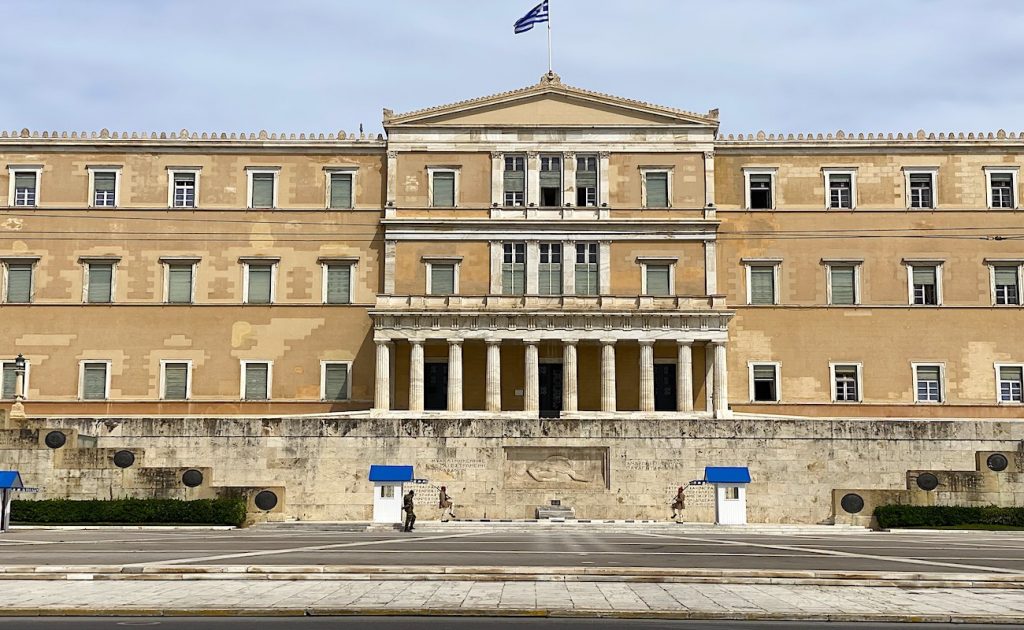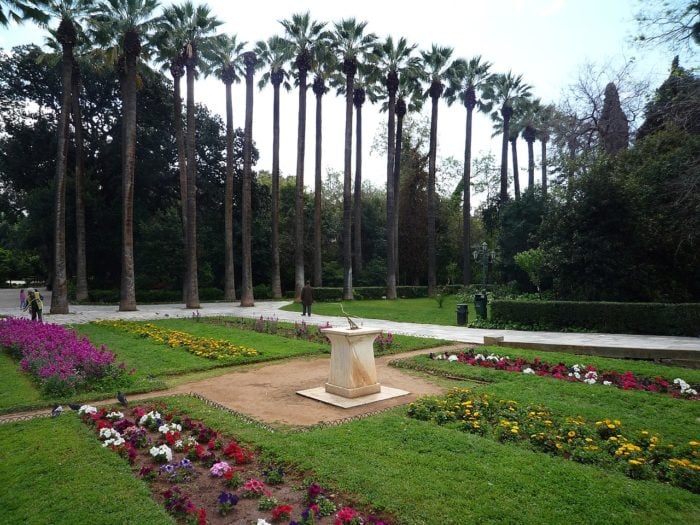
The history of Syntagma Square in Athens is literally the modern history of the city itself and the central point for visitors in the Greek capital.
Syntagma Square and—three quarters of a mile to the north—Omonoia Square, are completely intertwined with the history of the city and Greece in general from the King Otto reign (1832-1862) until today.
Syntagma (Constitution) has always been the promenade square of the city and was the gathering point for the cream of Athenian society in the late 19th and early 20th century.
Omonoia (Concord) Square, although initially of a bourgeois nature with luxurious cafes and nightclubs where partiers and bohemian types would gather, later became the hangout of provincials, loafers, laborers, and today, migrants.
Syntagma Square is also the starting point for the main sightseeing in Athens as most of the city’s landmarks are less than a mile away. Acropolis, Plaka. the Roman Agora, the Temple of Olympian Zeus and others are within walking distance.
History of Syntagma Square
Syntagma Square is the central square of Athens and the second largest in Greece, after Spianada Square in Corfu, and is included in the list of the 100 largest squares in the world.
It is delimited by Amalias and Vassileos Georgiou Avenue, and Stadiou and Othonos Streets. The numbering of the streets of Athens is based on Syntagma Square with each street number starting from there and even numbers on the right.
The history of Syntagma Square in Athens begins in the early 1830s, when the population of the city was about 7,000, and the area where the square stands was called Perivolakia. When the palace of King Otto was set to be built there, it was named Palace Square.
How Syntagma Square took its name
The palace was designed by Bavarian architect Friedrich von Gärtner for King Otto of Greece with funds donated by Otto’s father, King Ludwig I of Bavaria.
The specific location was chosen because the site was the highest point in central Athens, offering not only the view of Acropolis and the Parthenon but also a view of the sea, the Saronic Gulf. Construction work started in 1836 and was completed in 1843.
Gärtner designed an austere, functional, and compact building which respects the heritage of ancient Athens in keeping with the ideas of urban classicism.
It is accessible from all sides. Its four exterior wings have three floors each while the middle wing has two floors and two courtyards, as well as staircases which facilitate contact between the floors.
However, the name of Palace Square changed the same year the construction of the royal palace was completed.
On September 3, 1843, the name of the square changed to Constitution Square, as Otto was forced to cede to the Greek people gathered in front of the palace demanding a constitution.
Syntagma Square began to assume its modern shape after 1846 from the Bavarian Michael Hoch, who worked with the architect Leo von Klenze; its trees were planted according to the direction of Queen Amalia.
It was divided into two parts; the upper square (the eastern part) was still called “Palace Square” until the end of the 19th century while today it is known as “Parliament Square” or “the Monument of the Unknown Soldier.”
In 1922, the history of the palace changed. This was the year that the Greek royal family permanently abandoned the building.
At the same time, historical circumstances allowed its new uses. Government agencies and international organizations were now housed there, coordinating the work generated by the complex issues of the Asia Minor Catastrophe and the attendant influx of refugees.
The old palace building was gradually renovated over the years, becoming the seat of the Senate and the Council of State, along with the National Library, in 1934.
On July 1, 1935, the National Assembly officially began its work in the new Plenary Hall. From 1935 until today, the building has housed the Greek Parliament.

The lower square (western part) of Syntagma Square is also known as Bacchus Square or the Garden of the Muses. The two sections were on two different levels and joined by a marble staircase.
When the area of the Monument of the Unknown Soldier was created, the upper part was cut off from the rest of the square. The Monument was built in 1929 to 1930 by the architect Emmanuel Lazaridis.
Its central point is a representation of a felled ancient Greek soldier, created by sculptor Fokion Rok. On both sides, to the left and right of the monument, there are bronze plaques with the names of battles the Greeks fought from 1821 until today.
The Monument is guarded on a 24-hour basis by the soldiers of the Presidential Guard, the well-known Evzones, with the changing of the guard taking place every hour; it is one of the living attractions of Athens.
The square is inextricably linked to the historical events taking place in Greece over the centuries—a place of demonstrations, social upheavals, and protest demonstrations starting from September 3, 1843 through to today.
An event that was a black mark on the history of Syntagma Square in Athens was the killing of several demonstrators on December 3, 1944.

On December 3, 1944, less than two months after the country’s liberation from the Nazis, police shot at Greek People’s Liberation Army (EAM) demonstrators at Syntagma Square, thus starting almost two months of fighting in Athens, the so-called Dekemvriana.
The Dekemvriana battles between the British and Greek army against the communist guerillas of EAM cost many lives and destruction of several buildings in the capital. The bloody events were the precursor of the Greek Civil War (1946-1949).
A highlight of the modern history of Syntagma Square in Athens includes the massive election rallies of the mid-1970s through the early 1990s when New Democracy and PASOK were fighting for the governance of Greece.
Hundreds of thousands of people were gathered at Syntagma Square in the 1974, 1977, 1981, 1985, 1993, 1996 election rallies with the two main parties trying to outdo each other in the number of supporters.
From May 2011 through November of the same year, thousands of Greeks occupied Syntagma Square, protesting against the austerity measures brought by the country’s bailout program.
The so-called indignants who flooded the square for most part of the year with endless speeches and cultural happenings shaped the political forces of the 2010s through to today.
The big winner of the indignant movement that was cultivated at Syntagma Square was the leftist SYRIZA party that came to power in January 2015, the first party of the Left to govern Greece.
On February 4, 2018, in a mass protest rally, over one million people gathered to show their dissatisfaction over negotiations between Greece and the Former Yugoslav Republic of Macedonia (now North Macedonia) over the name of the Balkan country.
Keynote speaker in the rally was Greece’s iconic composer Mikis Theodorakis, who gave an emotional speech about Macedonia.
The crowd in the rally for Macedonia was probably the biggest in the history of Syntagma Square and Athens, surpassing the massive election rallies of the 1970s and 1980s.
Syntagma Square: The Athenians’ favorite
From early on, Syntagma Square played an important role in the daily life of Athenians. It was a meeting place, a favorite place for a Sunday walk, as well as a place to gather for musical presentations.
Syntagma Square has also been the bona fide place for big party election rallies. The election rallies of PASOK in the 1980s became legendary for the number of people attending.
Beginning in the middle of the 19th century, the construction of impressive mansions, luxury hotels, and cafes around the square gave it a true cosmopolitan flavor.
The buildings surrounding it, from the king’s palace to the Palli Mansion that set the tone, made Syntagma Square the most attractive place to spend one’s time.

Later, Hotel Grande Bretagne (formerly the A. Dimitriou Mansion), Hotel King George (formerly the Skouloudis house), and Athens Plaza (formerly the I. Vouros house) on the north side of the square added even more elegance.
Other than the Greek Parliament, the Pallis Mansion (at the corner of 1 Karageorgi Servias Street and Syntagma Square) is the only old building that survived the modernization of the capital.
Prime Minister Georgios Papandreou addressed the people of Athens from the balcony of the building after the liberation of Athens from the Germans in October 1944. Today, the Public department store is housed in the building.
Today, the building has thankfully been restored and houses Public, a multi-story technology store that also sells books, CDs, toys, and gadgets.
At the corner of Ermou Street and Syntagma Square there once was the Andreas Koromilas Mansion, as well, a two-story building that would have had another story if Queen Amalia had not asked the owner to stop construction so that it would not obstruct her view of the sea.
The building was later turned to the Zacharatos Cafe-Patisserie, one of the first to set up screens in the square in the summer and show silent films, accompanied by a piano. Later, two other cafes in the square followed Zacharatos’ example.
Syntagma Square in the 20th century
In the later part of the 20th century, the face of Syntagma Square changed drastically, and the mansions were replaced by concrete-and-glass modern office buildings housing state agencies and businesses.
The demolition of the glorious Negrepontis Palace at the junction of Amalia Avenue and Othonos Street in 1959 was characterized as a crime by architects.
The Negrepontis Palace was built in 1870 for aristocrat Loukia Louriotis and later, for a time, was used as the residence of the successor to the throne, Constantine, after his marriage to Sophia of Prussia in 1889 until the completion of the successor’s palace.
The successor’s palace was completed and now serves as the Presidential Mansion. After the successor to the throne left, the Negreponti Palace housed the seat of the 1896 Olympic Games Committee.
The mansions of the early Athens aristocracy tragically all vanished from the square along with the historical cafes and the Chrysakis Tea House, the first in Athens.

In 1984, artist Minos Argyrakis wrote about Athens: “Buildings are constantly flying in front of your eyes like a modern Greek bully, showing his stature…”
Today, next to the Grande Bretagne, two other luxury hotels, the King George and Athens Plaza, overlook Syntagma Square.
The former was the luxurious home of economist and politician Stefanos Skouloudis, who had served as prime minister from 1915 to 1916. The house was demolished in 1930, and the King George Hotel opened in 1936.
In the place of Athens Plaza was the house of Ioannis Vouros, and on the ground floor the historical Zacharatos Cafe-Patisserie operated from 1895 to 1963.
For many years, Athenians called the Zacharatos establishment the “second and more free—perhaps—Parliament, than the actual one.” Along with politicians, patrons of the Zacharatos patisserie were famous Athenians, scholars, journalists, and artists.
Syntagma Square is adorned with copies of five of the seven bronze statues donated by Lord Bute to the municipality of Athens in 1884.
The statues are “Hermes resting,” two deer, in an upright position and two wrestlers along with the sculpture “The child with the Grapes,” the work of Greek sculptor Dimitris Filippotis.
The bronze sculpture complex “Theseus saving Hippodamia,” the work of German sculptor Johannes Pfuhl, was originally placed in Syntagma Square but was later transferred to Victoria Square.

The National Garden
Adjacent to the upper part of Syntagma Square is the National Garden, a true oasis in the center of Athens with 500 different species of plant and tree species from around the world.
The National Garden is intertwined with the history of Syntagma Square and Athens, as it was initially established as the garden of the royal palace.
It covers a total area of 154,000 square meters (1,657,642 square feet) and features six ponds and many archaeological finds, mainly from Roman times, and a small zoo.
The National Garden, formerly known as the Royal Garden, began to take its current form during the reign of King Otto (1832 – 1862) and was the brainchild of Queen Amalia.
Queen Amalia was known for her love for the land and her effort to create beautiful green spaces in Athens influenced by the tradition of the gardens and parks of her homeland.
Queen Amalia was so smitten with her garden that she is said to have spent at least three hours a day personally tending to it.
She herself also planted the iconic 25-meter (75 foot) high “Washingtonia” palm trees which now tower over other garden plants and serve as the focal point when one enters the garden from the gate on Amalias Avenue.
The first design was made by Bavarian architect Lieutenant Michael Hoch and completed by the gardener François Louis Barrow in 1852; François Louis Barrow took over the planting and management of the garden from 1845 to 1854.
Barrow was succeeded by Frederick Smith, who remained in the director’s office of the garden for thirty years.
See all the latest news from Greece and the world at Greekreporter.com. Contact our newsroom to report an update or send your story, photos and videos. Follow GR on Google News and subscribe here to our daily email!



